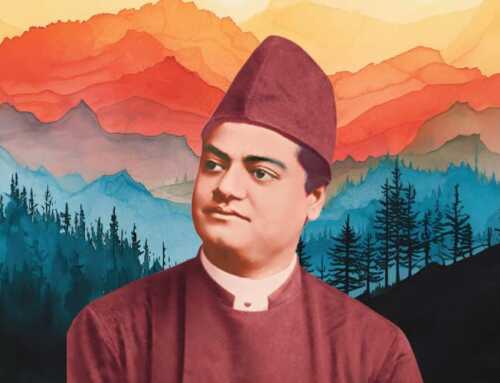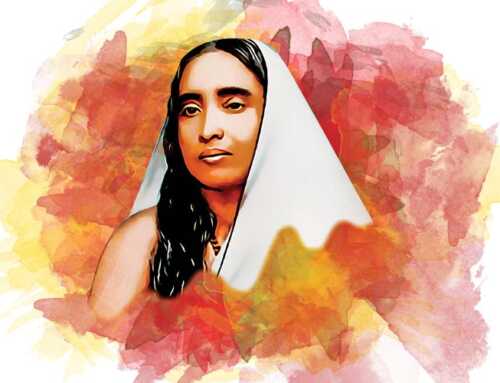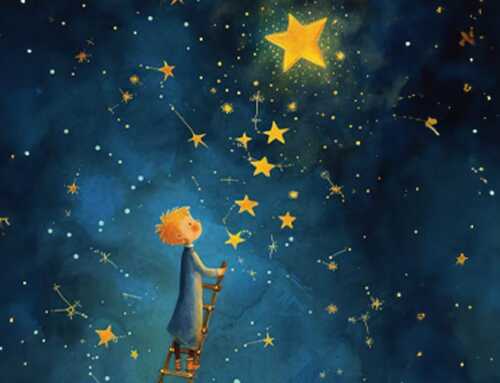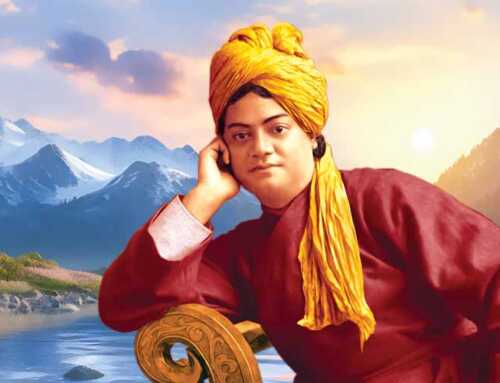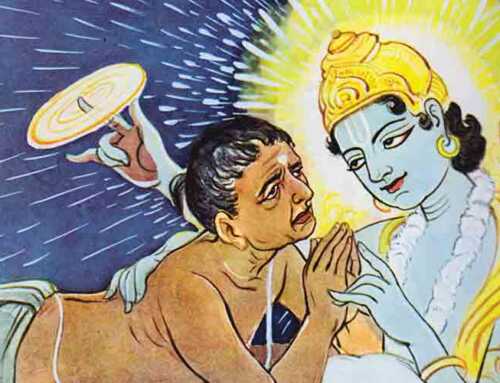Swami Krishnasakhananda is a monk of Ramakrishna Order looking after publication department of Shri Ramakrishna Ashrama, Rajkot.
• Jhaverchand Meghani (28 August 1896 – 9 March 1947):
He was a noted poet, writer, social reformer and freedom fighter from Gujarat. He was born in Chotila. Mahatma Gandhi spontaneously gave him the title of Raashtreeya Shaayar (National Poet). Besides this he received many awards like Ranjitram Suvarna Chandrak and Mahida Paaritoshik in literature. He authored more than 100 books. He was inspired by poems of Kavi Kalapi, Baul Sangeet and Rabindranath Tagore’s poems. His first book was a translation work of Rabindranath Tagore’s ballad, ‘Kathaa-o-Kaahinee’ titled ‘Kurbani Ni Kathao’ (Stories of martyrdom) which was first published in 1922. He contributed widely to Gujarati folk literature. He went from village to village in search of folk-lores and published them in various volumes of ‘Saurashtra Ni Rasdhar’ (1923-29). Some of his famous works are ‘Veni Na Phool’-1927, ‘Killol’-1930, ‘Sindhudo’-1930, ‘Kasumbi no Rang’, ‘Ravindra Veena’-1944, ‘Mansai na Diva’-1945 and many others.
• Akha Bhagat (approx. 1591-1656):
Akha Bhagat, commonly known as Akho or Akha Rahiyadas Soni was a medieval Gujarati poet who wrote in the tradition of the Bhakti movement. He wrote his poems in a literary form called Chhappa (six stanza satirical poems).
He is regarded as the most important poet of medieval Gujarati literature. Three of his works are dated including ‘Panchikarana’ (1645; Mixture of five elements), ‘Gurushishyasamvada’ (1645; A Dialogue between Teacher and a Pupil) and ‘Akhe-gita’, among which, Akhe-gita is considered as an important work. Divided in forty Kadavuns (sections), it deals with Bhakti (worship) and Jnana (knowledge). His other works includes ‘Chittavichar Samvada’, ‘Santona Lakshano’, ‘Anubhav Bindu’ (“A Drop of Experience”), Avasthanirupan’, ‘Kaivalya Gita’, as well as various Pada (poems) and Chhappa. His Chhappa, six stanza poems, are full of humorous and passes metaphorical comments on different aspects of spirituality and human life. He has written 746 Chhappas in total.
• Kavi Kalapi (26 January 1874-9 June 1900):
Sursinhji Takhtasinhji Gohil (1874–1900), popularly known by his pen name, Kalapi was a Gujarati poet and the Thakor (prince) of Lathi state in Gujarat. He is mostly known for his poems depicting his own pathos. He was educated at Rajkumar College, Rajkot. In spite of his short life of 26 years, poet Kalapi’s creation was immense and enormous. His creation includes about 250 poems (including 15,000 verses). He has also given a number of prose writings. His 900 letters to his friends and wives brought the facts and truth. He not only used Gujarati language as his medium to elaborate his own creation, but also translated four English novels in Gujarati. His famous works are ‘Kalapi no Kekarav’, ‘Kalapi no Kavyakalap’, ‘Kashmir no pravas’, ‘Swedenborg no Dharm Vichar’ and many others.
• Narsinh Mehta (15th century):
Narsinh Mehta was a 15th-century poet-saint of Gujarat, India, notable as a bhakta and an exponent of Vaishnava poetry. He is especially revered in Gujarati literature, where he is acclaimed as its Adi Kavi (Sanskrit for ‘first among poets’). His bhajan ‘Vaishnav Jan To’ was Mahatma Gandhi’s favourite and has become synonymous with him. How Krishna helped his beloved devotee in performing Mameru (a custom) of his daughter is depicted in ‘Mameru Na Pada’. Other famous works include ‘Hundi’ (Bond) episode and ‘Har Mala’ (Garland) episode, ‘Shamaldas no Vivah’, compositions depicting acceptance of Harijans, ‘Sudama Charit’, ‘Chaturis’, ‘Songs of Sringar’, and many more. His life events match events of several popular saint-poets like Surdas, Tulsidas, Meera, Kabir, Namdev and Sundarar.
• Gangasati
Gangasati was a medieval saint poet of bhakti tradition of western India who composed several devotional songs in Gujarati language. She was born in Vaghela Rajput family in Saurashtra region of present-day Gujarat state of India circa 12th to 14th century. She had a son, Ajobha, who was married to Panbai. To prove his spiritual powers, Kalubha, her husband, once resurrected a cow but later he regretted and decided to take samadhi and end his life. Gangasati urged him to let her take samadhi too, but he refused her and instructed to wait until she had perfected Panbai, her daughter-in-law, in the path of devotion. She agreed and composed devotional songs, bhajans, one per day for fifty one days to teach Panbai, the path of devotion. She took samadhi thereafter. She composed these bhajans each with a theme and spiritual teaching like importance and grace of Guru, life of a devotee, nature and words of Bhakti. They are composed as they are instructed to Panbai. Notably these bhajans do not mention any traditional Hindu deity but God in general, without any form or attributes. They reflect different aspects of the way of spiritual attainment.
• Umashankar Jethalal Joshi (21 July 1911 – 19 December 1988):
He was a poet, scholar and writer. He received the Jnanpith Award in 1967 for his contribution to Indian, especially Gujarati literature. Umashankar Joshi was born in small village named Bamna (now in Bhiloda Taluka of Aravalli district, Gujarat). Umashankar Joshi received inspiration for creative writing from the beautiful surroundings of the hilly region and the social life of the villages and fairs and festivals held there. He joined the freedom struggle led by Gandhi and gained an understanding of history. In 1929, he started his struggle by participating in the 34-day strike called by the students of Gujarat College. His collections ‘Hriday Ma Padeli Chhabio’ and ‘Ishamu Shida Ane Anya’ are the character sketches of the literary and historical figures whom he had met. His works include ‘Nishith’ – The God of Midnight (collection of poems), ‘Gangotri’, ‘Vishwashanti’ – World Peace, ‘Mahaprasthan’ and many others.
• Kanhaiyalal Maneklal Munshi (30 Dec. 1887 – 8 Feb. 1971):
He was an Indian independence movement activist, politician, writer and educationist from Gujarat state. A lawyer by profession, he later turned to literature and politics. He was a well-known name in Gujarati literature. He founded Bharatiya Vidya Bhavan, an educational trust, in 1938. He is well known for his historical novels in Gujarati, especially his trilogy ‘Patan-ni-Prabhuta’ (The Greatness of Patan), ‘Gujarat-no-Nath’ (The Ruler of Gujarat) and ‘Rajadhiraj’ (The Emperor). His other works include ‘Jay Somnath’ (on Somnath temple), ‘Krishnavatara’ (on Lord Krishna), ‘Bhagavan Parasurama’ (on Parshurama), and ‘Tapasvini’ (depicting the Lure of Power) a novel with a fictional parallel drawn from the Freedom Movement of India under Mahatma Gandhi. Munshi also wrote several notable works in English.
• Kaka Saheb Kalelkar (1 Dec. 1885 – 21 Aug. 1981):
Dattatreya Balkrushna Kalelkar, popularly known as Kaka Saheb Kalelkar, was an Indian independence activist, social reformer and journalist. He was a major follower of the philosophy and methods of Mahatma Gandhi. Mahatma Gandhi called him ‘Savai Gujarati’, a quarter more than a Gujarati. He received Sahitya Akademi Award in 1965 for his ‘Jeevan-Vyavastha’, a collection of essays in Gujarati. He was honoured with Sahitya Akademi Fellowship in 1971 for his literary achievements. The Government of India conferred on him Padma Vibhushan (India’s second-highest civilian award after the Bharat Ratna) in 1964. It also issued a commemorative stamp in his honour in 1985. His famous works in Gujarati are ‘Himalayano Pravas’, ‘Rakhadvano Anand’, ‘Geeta Darshan’, ‘Dharma’, etc. and in English are ‘Quintessence of Gandhian Thought’, ‘Mahatma Gandhi’s Gospel of Swadeshi’ and in Hindi are ‘Rashtriya Shiksha Ka Adarsha’, ‘Smaran Yatra’ and many more.
• Dalpatram Dahyabhai Travadi (21 January 1820 – 25 March 1898):
He was a Gujarati language poet during 19th century in India. He mastered the structures of rhyme, poiesis and ‘Vrajbhasha’ as a Swaminarayan devotee under Brahmanand Swami, and later moved to Ahmedabad at the age of 24. Dalpatram was a Sanskrit scholar and poet. Dalpatram taught Gujarati language to Alexander Kinloch Forbes, a British colonial administrator of Ahmedabad. Forbes and Dalpatram became close friends, and he inspired Dalpatram to write ‘Laxmi Natak’ published in 1849, the first play in Gujarati, based on Greek drama ‘Plutus’. At the end of the 19th century, he was entitled ‘Mahakavi’ (Great Poet) by Shahjanand Swami, the founder of Swaminarayan Sampraday. As a tribute to Dalpatram’s works, AMC and citizens of Ahmedabad proposed a memorial at the site of his house, which was destroyed in 1985. In the year 2001, the memorial became a part of Heritage walk of Ahmedabad. The design of his statue was debated before they came up with the idea of Kavi in sitting posture with a book in his lap. His career spanned 6 books and 25 awards including drama, poems, songs, essays and articles. ‘Hari Lila Amrut’, ‘Ven Charitra’, ‘Mithyabhiman’ and ‘Laxmi’ are his major contributions and others are ‘Laxmi’ (play), ‘Shrey’ (play), ‘Bapani Pinpar’ (poetry), etc.
• Kavi Narmad (24 August 1833 – 26 February 1886):
Narmadashankar Lalshankar Dave, popularly known as Narmad, was a Gujarati poet, playwright, essayist, orator, lexicographer and reformer under the British Raj. He is considered to be the founder of modern Gujarati literature. After studying in Bombay, he stopped serving as a teacher to live by writing. During his prolific career, he introduced many literary forms in Gujarati. He faced economic struggles but proved himself as a dedicated reformer, speaking loudly against religious and social orthodoxy. His essays, poems, plays and prose were published in several collections. His ‘Mari Hakikat’, the first autobiography in Gujarati, was published posthumously. His poem ‘Jai Jai Garvi Gujarat’ is now de facto the state anthem of Gujarat state of India. He promoted nationalism and patriotism with famous songs such as ‘Sahu Chalo Jeetva Jang’, wrote about self-government and discussed having one national language, Hindustani, for all of India, nearly five decades before Mahatma Gandhi or Nehru. His major collected works are ‘Narmagadya’, collection of prose; ‘Narmakavita’, collection of poems; ‘Narmakathakosh’, collection of stories of characters of mythological literature and ‘Narmakosh’, dictionary.
• Dayaram (16 August 1777 – 1853) :
He was a Gujarati poet of medieval Gujarati literature and was the last poet of the old Gujarati school. He was born in Chanod on the bank of Narmada river. He is known in Gujarati literature for his literary form called Garbi, lyric songs. He was a follower of Pushtimarg of Hindu Vaishnavism. Dayaram, along with Narsinh Mehta and Meera, is considered a major contributor during the Bhakti movement in Gujarati literature. He was a devotional poet and was a follower of ‘Nirgun bhakti sampraday’ (zushti sampraday) in Gujarat. He gave many Garbi describing Krishna as human being. He used many literary poetic forms to express his devotion. He also wrote long narrative poems based on the incidents on the Mahabharata such as ‘Rukmini Vivah’ (Marriage of Rukmini), ‘Satyabhama Vivah’ (Marriage of Satyabhama), ‘Ajamil Akhyana’ (Story of Ajamila), ‘Okhaharan’ (abduction of Aniruddha by Chitralekha).
• Pannalal Patel (7 May 1912 – 6 April 1989):
He was a Gujarati author. His father was a farmer and used to recite Ramayana, Okhaharan and other mythological stories for his village. This earned his house a nickname “abode of learning”. During school days, he befriended his schoolmate Umashankar Joshi. He wrote 61 novels, 26 short story collections and many other works such as ‘Sukhdukhna Sathi’ (1940) and ‘Vatrakne Kanthe’ (1952), and more than 20 social novels, such as ‘Malela Jeev’ (1941), ‘Manvini Bhavai’ (1947) and ‘Bhangyana Bheru’ (1957), and several mythological novels. He received the Jnanpith Award in 1985 for ‘Manvini Bhavai’. Some of his works were translated as well as adapted into plays and films. His novel ‘Na Chhutke’ (1955) is based on Satyagraha movements of Mahatma Gandhi and it enumerates Gandhi’s various endeavours for freedom of India and spiritual uplifting of Indian people. His other novels depicting rural life are ‘Bhangyana Bheru’ (1957), ‘Ghammar Valonu’ Vol 1-2 (1968), ‘Fakiro’ (1955), ‘Manakhavatar’ (1961), ‘Karoliyanu Jalu’ (1963), ‘Meen Matina Manvi’ (1966), ‘Kanku’ (1970), ‘Ajavali Rat Amasni’ (1971). His novels depict urban life as being less entertaining than rural life. During his later years, he wrote stories based on characters of epics, Mahabharata and Ramayana, and Puranas and other Hindu mythological stories. His such works include ‘Parth ne Kaho Chadave Ban’ Vol 1-5 (1974), ‘Rame Seetane Marya Jo!’ Vol 1-4 (1976), ‘Krishna Jivanleela’ Vol 1-5 (1977), ‘Shiva-Parvati’ Vol 1-6 (1979) and many others.
• Mareez (22 February 1917 – 19 October 1983):
Mareez, born Abbas Abdulali Vasi, was a Gujarati poet, mainly popular for his Ghazals. He is popularly known as Ghalib of Gujarat. He left studies in young age and started working in rubber shoe factory. Having interested in poetry, he took up journalism but remained financially unstable throughout his life. His popularity escalated after his death. His pen name, Mareez, literally means ‘a sick man’. He wrote some Nazm and many Ghazals. In his financially difficult times, he sold his creation for which he was not credited. His first collection of Ghazals, Nazm and Muktak; ‘Aagman’ was published in 1975. His second collection ‘Nakhsha’ was published posthumously in 1984. Some of his poems were published in Disha (1980) along with others. His complete works, ‘Samagra Mareez’, was published by his son in 2012.
• Dula Bhaya Kag (25 Nov. 1902 – 2 Feb. 1977):
He was an Indian poet, songwriter, writer and artiste born in 1902 in Sodvadri village, a village in the Saurashtra Region, near Mahuva in the Indian state of Gujarat. He was of the Charan caste and is mainly known for his work on spiritual poetry relating to Hinduism. He became involved in the nationalist movement and prohibition after the formation of Saurashtra State, causing him to donate his land to Vinoba Bhave’s Bhoodan Movement. Kag is known for publishing ‘Kagvani’, an eight-volume work consisting of devotional songs (episodes from the Ramayana and the Mahabharata), as well as songs based on Gandhian philosophy and the Bhoodan movement. He wrote eulogies for Mahatma Gandhi and Bhave. As a result of his literary and political contributions to India, the country awarded him the Padma Shri award in 1962. Despite his limited education, his poems are used from primary education to master’s programs. On 25 November 2004, the Department of Posts released a commemorative stamp from Ahmedabad in denomination of INR 5.0 to mark his 102nd anniversary.
Your Content Goes Here

